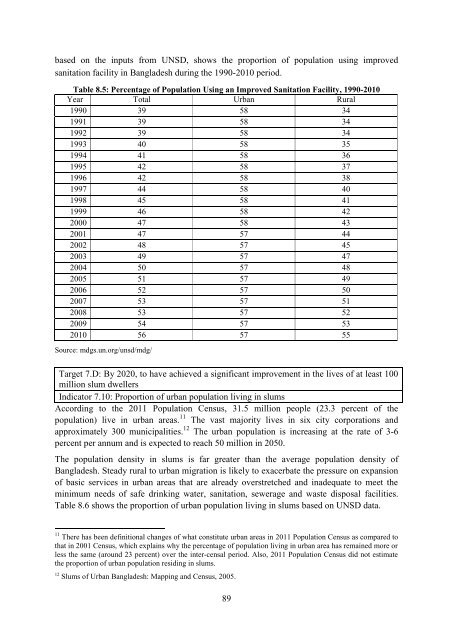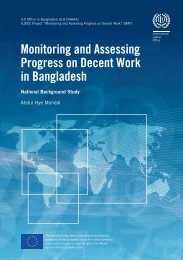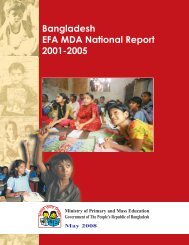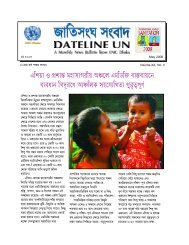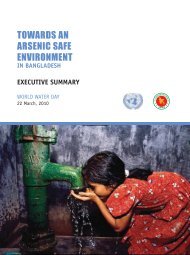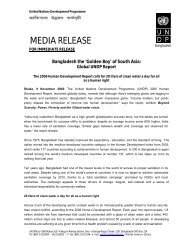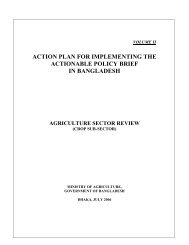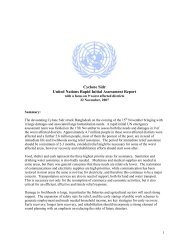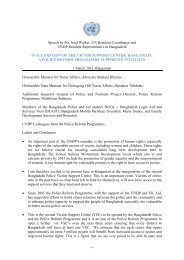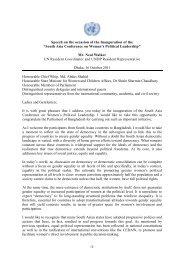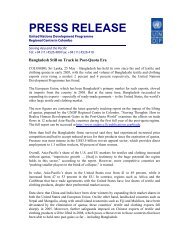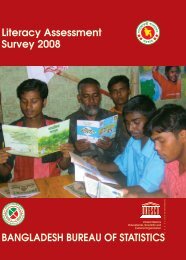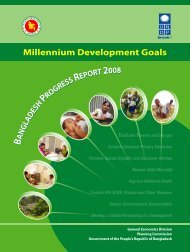MDG Report 2012 - United Nations in Bangladesh
MDG Report 2012 - United Nations in Bangladesh
MDG Report 2012 - United Nations in Bangladesh
- No tags were found...
Create successful ePaper yourself
Turn your PDF publications into a flip-book with our unique Google optimized e-Paper software.
ased on the <strong>in</strong>puts from UNSD, shows the proportion of population us<strong>in</strong>g improvedsanitation facility <strong>in</strong> <strong>Bangladesh</strong> dur<strong>in</strong>g the 1990-2010 period.Table 8.5: Percentage of Population Us<strong>in</strong>g an Improved Sanitation Facility, 1990-2010Year Total Urban Rural1990 39 58 341991 39 58 341992 39 58 341993 40 58 351994 41 58 361995 42 58 371996 42 58 381997 44 58 401998 45 58 411999 46 58 422000 47 58 432001 47 57 442002 48 57 452003 49 57 472004 50 57 482005 51 57 492006 52 57 502007 53 57 512008 53 57 522009 54 57 532010 56 57 55Source: mdgs.un.org/unsd/mdg/Target 7.D: By 2020, to have achieved a significant improvement <strong>in</strong> the lives of at least 100million slum dwellersIndicator 7.10: Proportion of urban population liv<strong>in</strong>g <strong>in</strong> slumsAccord<strong>in</strong>g to the 2011 Population Census, 31.5 million people (23.3 percent of thepopulation) live <strong>in</strong> urban areas. 11 The vast majority lives <strong>in</strong> six city corporations andapproximately 300 municipalities. 12 The urban population is <strong>in</strong>creas<strong>in</strong>g at the rate of 3-6percent per annum and is expected to reach 50 million <strong>in</strong> 2050.The population density <strong>in</strong> slums is far greater than the average population density of<strong>Bangladesh</strong>. Steady rural to urban migration is likely to exacerbate the pressure on expansionof basic services <strong>in</strong> urban areas that are already overstretched and <strong>in</strong>adequate to meet them<strong>in</strong>imum needs of safe dr<strong>in</strong>k<strong>in</strong>g water, sanitation, sewerage and waste disposal facilities.Table 8.6 shows the proportion of urban population liv<strong>in</strong>g <strong>in</strong> slums based on UNSD data.11 There has been def<strong>in</strong>itional changes of what constitute urban areas <strong>in</strong> 2011 Population Census as compared tothat <strong>in</strong> 2001 Census, which expla<strong>in</strong>s why the percentage of population liv<strong>in</strong>g <strong>in</strong> urban area has rema<strong>in</strong>ed more orless the same (around 23 percent) over the <strong>in</strong>ter-censal period. Also, 2011 Population Census did not estimatethe proportion of urban population resid<strong>in</strong>g <strong>in</strong> slums.12Slums of Urban <strong>Bangladesh</strong>: Mapp<strong>in</strong>g and Census, 2005.89


